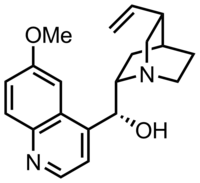
Photo from wikipedia
BackgroundIntravenous artesunate and its follow on full course dihydroartemisinin–piperaquine are the standard treatment for severe malaria in Indonesia. The current policy suggests that intravenous and oral quinine could be used… Click to show full abstract
BackgroundIntravenous artesunate and its follow on full course dihydroartemisinin–piperaquine are the standard treatment for severe malaria in Indonesia. The current policy suggests that intravenous and oral quinine could be used when standard therapy is not available. Its pragmatic use of both treatment combinations in a field hospital is evaluated.MethodsA retrospective study among hospitalized malaria patients receiving intravenous anti-malarial treatments at Mitra Masyarakat Hospital, Timika from April 2004 to December 2013 was conducted. The length of hospital stay (LoS) and the risk of malaria recurrence within 28 days after hospital admission were compared between patients receiving intravenous artesunate and oral dihydroartemisinin–piperaquine (Iv Art + DHP) and those receiving intravenous and oral quinine (Iv + Oral Qu).ResultsOf 10,514 patients requiring intravenous therapy, 2759 received Iv + Oral Qu and 7755 received Iv Art + DHP. Plasmodium falciparum infection accounted for 65.8% (6915), while Plasmodium vivax, Mixed infections, Plasmodium malariae and Plasmodium ovale were accounted for 17.0% (1789), 16.4% (1729), 0.8% (79) and 0.01% (2) of the infections, respectively. The majority of severe malaria hospital admissions were highland Papuans (78.0%, 8201/10,501). In total 49% (5158) of patients were older than 15 years and 3463 (32.9%) were children under 5 years old. The median LoS was shorter in patients receiving intravenous artesunate compared to those treated with intravenous quinine (median = 2 [IQR 1–3] versus 3 days [IQR 2–4], p < 0.0001). Patients treated with intravenous quinine had higher risk of being hospitalized longer than 2 days (aOR of 1.70 [95% CI 1.54–1.88], p < 0.0001). The risk of recurrences within 28 days after hospital admission was 1.94 times higher (95% CI aHR 1.57–2.39, p < 0.0001) in patients receiving intravenous quinine with follow on oral quinine treatment than in patients treated with DHP after intravenous artesunate therapy.ConclusionsIntravenous artesunate reduced the LoS of malaria patients and in combination with DHP reduced the risk of malaria recurrence within 28 days after hospital admission compared to those with Iv + Oral Qu treatment. Thus, ensuring continuous supply of intravenous artesunate and artemisinin-based combination therapy (ACT) should be a priority.
Journal Title: Malaria Journal
Year Published: 2019
Link to full text (if available)
Share on Social Media: Sign Up to like & get
recommendations!